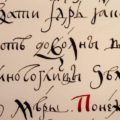The School of Historical Calligraphy has been working in the heart of Moscow for 10 years. Knowledgeable mentors help students master the art of writing like that of the monks in scriptoriums in the 11th century or the scribes of the early Romanov era.
Write like an artist
From Greek, calligraphy can be translated as “beautiful writing”. However, it is not only about beauty, but also refers to rhythm, harmony, and proportionality of all elements. Unsurprisingly, according to a poetic definition of this art, “calligraphy is architecture without constructions and materials.” In many cultures, calligraphy is more than just writing. For example, in Japan it is a means of meditation, and in Arab countries, the rulers vowed to make a copy of the Quran, for which purpose they mastered at least the basics of calligraphy. Jews still practice sacred calligraphy — the traditional writing of Torah scrolls. What is more, calligraphy plays a huge role in the history of European writing.
At present, calligraphy is something sophisticated, the desire to write beautifully by hand the letters that normally are typed on a computer. However, in the past, almost any text had an important aesthetic component. In this regard, the School of Historical Calligraphy focuses not only on beautiful manuscripts, but also on any historical writing, as long as it reflects the development of the system.
The School teaches how some types of writing replace others and where new forms of letters come from. After all, it has always been like that — a certain form that was initially a fast scribble gradually integrated into the system and literally became part of beautiful writing. Actually, all lowercase letters whose forms differ from uppercase letters have gone right this way, both in the Latin and Cyrillic alphabets.
Thus, the School actually explores the history of writing, and this history is inextricably linked with beauty.
From Ostromir to Peter the Great
Russian and European calligraphic traditions originate from the Greek alphabet. In Europe, calligraphy evolved from Roman capital letters to modern school handwriting and graffitis in subway tunnels. In Russia, the art of beautiful writing had its own development stages.
The Glagolitic script is the very first Slavic alphabet developed by Cyril and Methodius in the 9th century. The Glagolitic letters are so bizarre that one understands immediately that they were invented, rather than evolved over centuries in the writings of thousands of scribes. Due to its complexity (one might even say impracticality!) the Glagolitic alphabet was replaced by the time-tested Greek alphabet within 50–100 years by simply adding letters to denote specific Slavic phonemes. This is how the Cyrillic alphabet appeared.
Uncial is the first Cyrillic type of writing. Uncial letters are clear, geometric, have no slanting, and with some space from each other. Uncial looks strict and solemn. It is uncial that was used to create the oldest dated East Slavic manuscript that has come down to us — the Ostromir Gospel (1056–1057).
Minor uncial is the writing style of the times of the Tatar-Mongol invasion. It is really peculiar: many elements are written not with one stroke, but with two. Despite this, minor uncial is simpler in terms of writing than the original uncial, and a scribe did not need such a high qualification. The famous Kyiv Psalter of 1397 was written in minor uncial.
Writing tends to evolve towards greater convenience and speed. If a letter can be written in two strokes instead of five, then this is what will become common. Basically, this is why letter “Ж” of the 18th century is strikingly different from its distant relative of the 11th century.
The semi-uncial script is a style of ancient Russian calligraphy in which the letters are smaller, more rounded and have numerous superscripts. This is the most highly skilled type of ancient Russian writing. It can be called an excellent compromise between comfort for the hand and beauty for the eye. The Moscow Gospel of 1507 and the famous Chronicle of Ivan the Terrible are the samples of semi-uncial.
Vyaz is a type of decorative writing that was widely used in the 15th–17th centuries. Its letters are connected with each other in a beautiful ornament. Obviously, it is not a good idea to use Vyaz as a book script, but it can make a great heading or page decoration.
Skoropis was used from around the 15th century to the period of Peter the Great, and later, almost the whole 18th century. This style of calligraphy has national specifics: it is almost impossible to write Latin letters with Skoropis. This type of writing is very expressive due to dashing long strokes and the use of ligatures, when two letters seem to merge into one. The most characteristic examples of developed Russian Skoropis date back to the 17th century, the time when most books were made in printing houses rather than written by hand. Therefore, at that time, calligraphy was more often demonstrated not in a book-writing workshop, but in an office by clerks. Business papers of various nature are the typical example of Skoropis.
So many letters, so many stories, and these stories are full of incredible plot twists! For example, Russian printed capital letter “Д” still looks like its progenitor — Greek letter delta, whereas the capital handwritten “Д” acquired the form of the Latin handwritten “D” in the course of its evolution.
Forward to the past
Today, calligraphy is becoming increasingly popular. We see calligraphic inscriptions in outdoor advertising, on postcards, invitations, logos, and even in menus. In fact, the School of Historical Calligraphy does not aim to train practicing artists. In their training courses, the founders of the School, Andrei Sannikov and Yuriy Koverdyaev rather provide the basics of the art. Students get a chance to look at modern letters from a new perspective when they learn their history. This explains why the course proceeds in chronological order from uncial to Skoropis, although uncial requires greater mastery than other types of ancient Russian calligraphy, and it may not seem logical to begin with it.
The classes are held in the ancient Averky Kirillov Chambers, an architectural monument of the 17th century. People from all walks of life come to try themselves as a medieval scribe — Russian language teachers, jewelers, lawyers, designers, and even priests. By literally touching history with their own fingers, the founders and guests of the School of Old Russian Calligraphy help to preserve the art of ancient writing.
Tatiana Borisova





